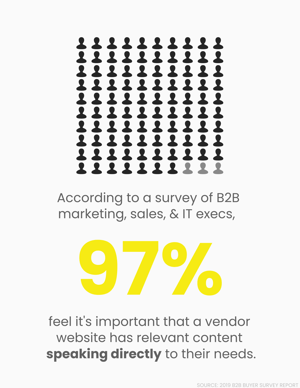4 Strategies for Using Buyer Personas in every B2B Content Marketing Campaign
Jul 21, 2020 / By Sydney Anderson
One of the biggest mistakes I see so many B2B companies making in their messaging is a lack of personalization. And in this digital age, there’s no excuse for it.
Too many companies are focused on selling rather than making connections through their marketing – particularly their content marketing.
Now I know you’re thinking, “But Sydney, ‘making connections’ isn’t going to increase ROI or improve sales numbers.”
That’s where I kindly agree to disagree with you. In fact, according to a recent survey, 97% of senior-level B2B decision-makers said it’s important that a company website has relevant content that speaks directly to them and their company – 68% ranking it as very important.
I don’t know about you, but I feel like that’s reason enough to start making those connections and weaving in personalization wherever possible.
So now let’s talk about how you achieve a deep level of personalization in your strategy. I’ve said it once, and I’ll say it again: Buyer personas hold the key to a deeper understanding of your target audience.
But it’s not enough to just write the buyer personas; you have to use them.
Sometimes, easier said than done, but I’ve created a guide to help you use your B2B buyer personas in every B2B content marketing campaign you run.
1. Blogs and Website Content
Possibly the place I see the biggest offenders: B2B websites. So many websites, particularly those with a tech-focus, are littered with jargon or internal terminology. This only leads to confusion and disconnect for your viewers.
Don’t feel bad. You certainly aren’t the first, and you won’t be the last, to add jargon to your content. It’s extremely difficult to separate yourself from something you’ve done for years or eliminate terms in your writing that you use day in and day out.
But, an easy way to remove yourself from this mindset is to think like your target audience. Read through their profiles or personas, and think what you would want to know, and how you’d like it presented if you were in their position, with their pain points, their objectives, and their role.
It feels strange at first, but soon it’ll come naturally. That’s where the real magic happens. Just keep trying to write content with your audience at the forefront and eventually it will be second-nature.
2. Organic Social Content
I also see a lot of B2B selling rather than delighting on social media. Or, sometimes, I see the opposite where brands are compromising their authority to share poorly-timed memes just to stay hip.
I understand it can be difficult to be a serious brand among selfies, food pictures, and Baby Yoda memes. I see where many brands have the best intentions to engage their audience and simply just fall short.
But rather than harping on what isn’t working, I’ll tell you what does work: Conversations. Yes, it’s that simple.
Sharing memes and keeping up with viral crazes can work, as long as you make it relevant for your audience. However, my advice would be to do so sparingly. I challenge you to frame yourself as an industry thought leader rather than sacrifice your reputation to blend in with the crowd.
You become a thought leader by sparking conversation about the latest industry news and trends. Many brands are afraid to have an opinion on, well, just about anything. But customers want to see your authenticity and thoughtfulness on a subject relevant to them. Now, I’m not telling you to be offensive, but don’t be afraid to take a stance or share insightful tidbits from an article you found on LinkedIn.
Frame your posts and insights around your buyer personas by staying on trend with the different industries your personas are in and keeping up with topics that match their pain points or interests. Note specific articles or post content that encourage engagement, and start using more of that.
3. Email Marketing
Email marketing is one of the tried and true digital marketing platforms that isn’t going anywhere. And the best part is email makes it extremely easy to customize and segment based on audience.
Start by segmenting your contact list into your varying buyer personas. Then from here, tweak your email content so it is relevant to that audience. Only show them content or offers that their particular interests align with. Using this dynamic content will improve your open and click-through rates almost immediately.
Pro tip: You don’t have to write multiple emails! A) that takes too long and B) it’s just not necessary. Start with the same base email content – whether it’s a special offer or your weekly newsletter – and simply customize one section based on your list. Whether it’s the offer copy or the type of articles you’re putting in email, your contacts will thank you for the personalized content.
4. Paid Digital Ads
By far one of the easiest content marketing forms to completely tailor messaging based on audience, paid digital advertising has changed the game when it comes to reaching your customers. Selecting customized audience criteria based on interests, demographics, and industry ensures the right messages are hitting the right people at the right time.
When you’re developing your paid ads, be sure to develop your targeted audiences based on your persona profiles. From there, develop ads for these individual segments based on their pain points and interests.
Key Takeaways to Personalizing your B2B Content Marketing Strategy
- Try to eliminate jargon or internal terminology from your website and blogs. Think about your personas and how they would want information to be relayed.
- Don’t blend in on social media. Share relevant and thoughtful content that sparks conversation with your audience.
- Segment your email lists and create dynamic content sections that will change based on who the email is sent to.
- Develop audience segments for your paid digital ads that closely align with your buyer persona demographics and interests.
Mastering content that aligns with your buyer personas and target audience’s needs can be challenging. It will take time. Just remember to keep their needs at the forefront of your content, and soon you will be writing with your customers in mind without realizing it.
Sign up for our insights on the convergence of business and PR



